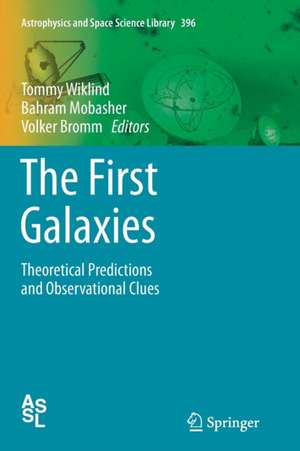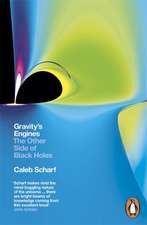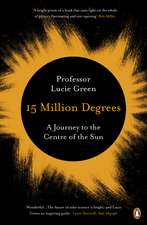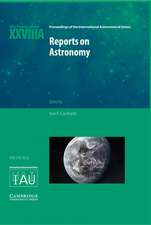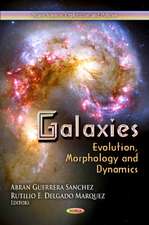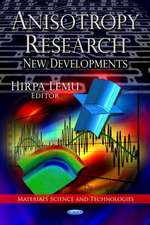The First Galaxies: Theoretical Predictions and Observational Clues: Astrophysics and Space Science Library, cartea 396
Editat de Tommy Wiklind, Bahram Mobasher, Volker Brommen Limba Engleză Paperback – 29 ian 2015
This volume brings together leading experts in the field to discuss our current level of understanding and what may come in the near future as our observational as well as theoretical tools improve. The book confronts the theory of how the first stars, black holes, and galaxies formed with current and planned observations. This synthesis is very timely, just ahead of the establishment of major new facilities, such as the James Webb Space Telescope (JWST), a next-generation, millimeter/sub-millimeter observatory in the Atacama desert (ALMA), and ground-based Extremely Large Telescopes (ELT). Together, they will revolutionize the study of the most distant objects in the Universe.
This volume is aimed at beginning graduate students but can also serve as a reference work for active researchers in the field. Apart from presenting the fundamental concepts involved, it also provides an introduction to the methods and techniques used. The book will also be useful to anyone with an astrophysical background who needs an effective starting point for learning about the first stars and galaxies.
Din seria Astrophysics and Space Science Library
- 24%
 Preț: 799.08 lei
Preț: 799.08 lei - 15%
 Preț: 647.92 lei
Preț: 647.92 lei - 18%
 Preț: 983.81 lei
Preț: 983.81 lei - 18%
 Preț: 790.28 lei
Preț: 790.28 lei -
 Preț: 359.85 lei
Preț: 359.85 lei -
 Preț: 389.70 lei
Preț: 389.70 lei - 20%
 Preț: 691.13 lei
Preț: 691.13 lei - 18%
 Preț: 1011.27 lei
Preț: 1011.27 lei -
 Preț: 402.56 lei
Preț: 402.56 lei - 15%
 Preț: 664.93 lei
Preț: 664.93 lei -
 Preț: 398.15 lei
Preț: 398.15 lei - 18%
 Preț: 954.77 lei
Preț: 954.77 lei -
 Preț: 411.04 lei
Preț: 411.04 lei - 18%
 Preț: 1225.31 lei
Preț: 1225.31 lei - 18%
 Preț: 1843.29 lei
Preț: 1843.29 lei -
 Preț: 393.13 lei
Preț: 393.13 lei -
 Preț: 400.26 lei
Preț: 400.26 lei - 18%
 Preț: 953.82 lei
Preț: 953.82 lei - 18%
 Preț: 960.61 lei
Preț: 960.61 lei -
 Preț: 398.35 lei
Preț: 398.35 lei -
 Preț: 390.84 lei
Preț: 390.84 lei -
 Preț: 413.76 lei
Preț: 413.76 lei -
 Preț: 416.64 lei
Preț: 416.64 lei - 18%
 Preț: 947.67 lei
Preț: 947.67 lei -
 Preț: 404.51 lei
Preț: 404.51 lei - 18%
 Preț: 956.50 lei
Preț: 956.50 lei -
 Preț: 403.75 lei
Preț: 403.75 lei - 18%
 Preț: 1229.40 lei
Preț: 1229.40 lei - 18%
 Preț: 1224.99 lei
Preț: 1224.99 lei -
 Preț: 404.29 lei
Preț: 404.29 lei - 15%
 Preț: 654.77 lei
Preț: 654.77 lei - 18%
 Preț: 1248.20 lei
Preț: 1248.20 lei - 18%
 Preț: 955.25 lei
Preț: 955.25 lei - 18%
 Preț: 1846.28 lei
Preț: 1846.28 lei - 18%
 Preț: 1233.06 lei
Preț: 1233.06 lei - 18%
 Preț: 1234.77 lei
Preț: 1234.77 lei -
 Preț: 411.64 lei
Preț: 411.64 lei
Preț: 647.40 lei
Preț vechi: 761.65 lei
-15% Nou
Puncte Express: 971
Preț estimativ în valută:
123.90€ • 127.99$ • 103.11£
123.90€ • 127.99$ • 103.11£
Carte tipărită la comandă
Livrare economică 26 martie-09 aprilie
Preluare comenzi: 021 569.72.76
Specificații
ISBN-13: 9783642448607
ISBN-10: 3642448607
Pagini: 430
Ilustrații: X, 430 p.
Dimensiuni: 155 x 235 x 23 mm
Greutate: 0.61 kg
Ediția:2013
Editura: Springer Berlin, Heidelberg
Colecția Springer
Seria Astrophysics and Space Science Library
Locul publicării:Berlin, Heidelberg, Germany
ISBN-10: 3642448607
Pagini: 430
Ilustrații: X, 430 p.
Dimensiuni: 155 x 235 x 23 mm
Greutate: 0.61 kg
Ediția:2013
Editura: Springer Berlin, Heidelberg
Colecția Springer
Seria Astrophysics and Space Science Library
Locul publicării:Berlin, Heidelberg, Germany
Public țintă
ResearchCuprins
Part I The First Sources of Light.- Chapter 1 The Basic Theoretical Framework.- Chapter 2 The Epoch of Reionization.- Chapter 3 The First Stars.- Part II The First Galaxies and Normal Stellar Populations.- Chapter 4 Formation of the First Galaxies: Theory and Simulations.- Chapter 5 Observing the First Galaxies.- Chapter 6 The Formation of the First Massive Black Holes.- Part III Tools & Techniques.- Chapter 7 Evolutionary Synthesis Models as a Tool and Guide Towards the First Galaxies.- Chapter 8 Exploring the Universe with Metal-Poor Stars.- Chapter 9 The Potential Impact of Future Observatories.
Recenzii
From the reviews:
“The First Galaxies is one of several recent books which attempt to review our current understanding of the rapidly changing research area of astrophysics dealing with the formation, evolution, and impact of the first stars and galaxies to form in the early history of the Universe. … this volume will serve as an excellent research resource for advanced undergraduate and post-graduate researchers studying high-redshift galaxy formation, either from a theoretical or observational standpoint.” (Ross McLure, The Observatory, Vol. 133 (1237), December, 2013)
“The First Galaxies is one of several recent books which attempt to review our current understanding of the rapidly changing research area of astrophysics dealing with the formation, evolution, and impact of the first stars and galaxies to form in the early history of the Universe. … this volume will serve as an excellent research resource for advanced undergraduate and post-graduate researchers studying high-redshift galaxy formation, either from a theoretical or observational standpoint.” (Ross McLure, The Observatory, Vol. 133 (1237), December, 2013)
Notă biografică
Tommy Wiklind (ESO/Joint ALMA Observatory), Bahram Mobasher (UCLA, Riverside) and Volker Bromm (University of Texas, Austin) are leaders in the field of first stars and first galaxies.
Textul de pe ultima copertă
New observations of the period between the cosmic recombination and the end of reionization are posing intriguing questions about where the first generations of stars were formed, how the first galaxies were assembled, whether these galaxies have low redshift counterparts, and what role the early galaxies played in the reionization process. Combining the new observational data with theoretical models can shed new light on open issues regarding the star formation process, its role in the reionization of the Universe, and the metal enrichment in galaxies at those early epochs.
This volume brings together leading experts in the field to discuss our current level of understanding and what may come in the near future as our observational as well as theoretical tools improve. The book confronts the theory of how the first stars, black holes, and galaxies formed with current and planned observations. This synthesis is very timely, just ahead of the establishment of major new facilities, such as the James Webb Space Telescope (JWST), a next-generation, millimeter/sub-millimeter observatory in the Atacama desert (ALMA), and ground-based Extremely Large Telescopes (ELT). Together, they will revolutionize the study of the most distant objects in the Universe.
This volume is aimed at beginning graduate students but can also serve as a reference work for active researchers in the field. Apart from presenting the fundamental concepts involved, it also provides an introduction to the methods and techniques used. The book will also be useful to anyone with an astrophysical background who needs an effective starting point for learning about the first stars and galaxies.
This volume brings together leading experts in the field to discuss our current level of understanding and what may come in the near future as our observational as well as theoretical tools improve. The book confronts the theory of how the first stars, black holes, and galaxies formed with current and planned observations. This synthesis is very timely, just ahead of the establishment of major new facilities, such as the James Webb Space Telescope (JWST), a next-generation, millimeter/sub-millimeter observatory in the Atacama desert (ALMA), and ground-based Extremely Large Telescopes (ELT). Together, they will revolutionize the study of the most distant objects in the Universe.
This volume is aimed at beginning graduate students but can also serve as a reference work for active researchers in the field. Apart from presenting the fundamental concepts involved, it also provides an introduction to the methods and techniques used. The book will also be useful to anyone with an astrophysical background who needs an effective starting point for learning about the first stars and galaxies.
Caracteristici
Provides state-of-the art knowledge of the origins of the very first stars and galaxies with observational clues and predictions which will lead to a coherent understanding of the early universe Very timely topic, since ample observational and theoretical progress has been made recently Prepares researchers for new observation facilities that will become available in the next 3-5 years Written by active researchers in the field One of the few books covering both observational and theoretical aspects of the Dark Ages of the Universe, with enough background and up-to-date information Includes supplementary material: sn.pub/extras
